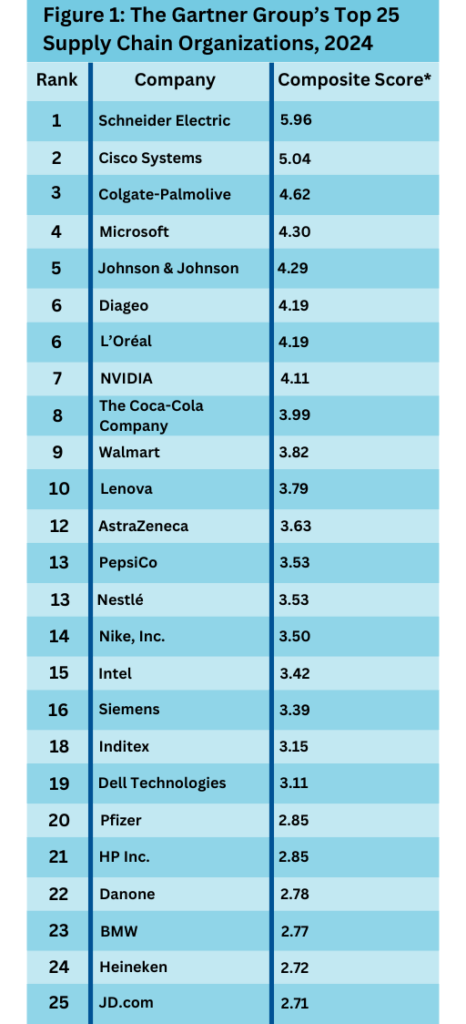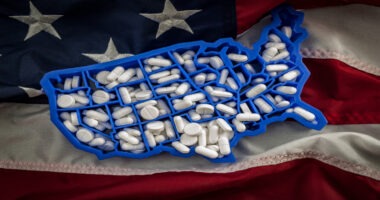The Top 25 Supply Chain Organizations: Where Does Pharma Rank?
Which companies have the highest ranked global supply-chain organizations? Three bio/pharma companies made the cut in the Gartner Group’s annual ranking of the top 25 supply-chain organizations. Who are they, and what does it take to be in the top?
By Patricia Van Arnum, Editorial Director, DCAT, mailto:pvanarnum@dcat.org

*The Supply Chain Top 25 ranking comprises two main components: business performance and community opinion. Business performance in the form of public financial and ESG (environmental, social, governance) data provides a view into how companies have performed in the past three years while the community opinion component gives a peer and Gartner expert view to companies’ future potential and reflects leadership in the supply chain community. These two components are combined into a total composite score.
Gartner derives a list of companies from a combination of the Fortune Global 500 and the Forbes Global 2000. In an effort to maintain the list of companies evaluated at a manageable level, a general annual revenue threshold of $15 billion was applied and companies without physical supply chains are excluded.
Composite score: (Peer score x 25%) + (Gartner expert score x 25%) + (ROPA score x 5%) + (ROPA change score x 10%) + (Revenue growth score x 10%) + (Inventory turns score x 5%) + (ESG points x 20%)
Source: The Gartner Group
Ranking the top supply-chain organizations
In its annual assessment of the companies with the top supply chain organizations, the management consulting firm, the Gartner Group, uses a composite score to rank leading supply-chain organizations and identifies the best practices and characteristics of these top performers.
The Supply Chain Top 25 ranking comprises two main components: business performance and community opinion. Business performance in the form of public financial and ESG (environmental, social, and governance) data provides a view into how companies have performed in the past three years while the community opinion component gives a peer and Gartner expert view to companies’ future potential and reflects leadership in the supply chain community. These two components are combined into a total composite score. The composite score is based on the following components: peer opinion score, 25%; Gartner expert score, 25%; return on physical assets (ROPA) score, 5%; ROPA change score, 10%; inventory turns score, 5%; revenue growth score, 10%; and an ESG component score, 20%.
Gartner derives a list of companies from a combination of the Fortune Global 500 and the Forbes Global 2000. In an effort to maintain the list of companies evaluated at a manageable level, a general annual revenue threshold of $15 billion was applied, and companies without physical supply chains were excluded.
“The supply chain organizations in this year’s Top 25 were notable for better protecting growth rates in a challenging operating environment while at the same time delivering more sustainable operations,” said Simon Bailey, Vice President Analyst with the Gartner Supply Chain Practice. “The best supply chains now have ESG criteria firmly embedded in their operations while delivering higher than average growth rates, better returns on physical assets (ROPA), and stronger margins.”
Ranking the top 25 supply chain organizations
Schneider Electric retained the top position in the list this year (2024), followed in second place by Cisco Systems. Colgate-Palmolive, Microsoft, and Johnson & Johnson completed the top five positions. New to this year’s list was Nvidia, a multinational technology company, which surged into the Top 25 on the back of strong financial performance to land in the seventh position (see Figure 1).
“Schneider Electric again performed strongly across every component of the methodology including securing the highest number of Gartner expert votes,” said the Gartner Group’s Bailey. “The company is reaping the benefits of a three-year transformation initiative that has strengthened customer and supplier relationships while improving the resilience of [its] operations.”
Looking at representation in the Top 25 rankings among bio/pharmaceutical companies, three companies made the cut: Johnson & Johnson (ranked 5th), AstraZeneca (ranked 12th), and Pfizer (ranked 20th) (see Figure 1).
Gartner continues to recognize sustained supply chain excellence via the “Masters” category, first introduced in 2015. To be considered Masters, companies must have attained top-five composite scores for at least seven out of the last 10 years. Amazon, Apple, Procter & Gamble, and Unilever all retained their Masters category status this year (2024).
Characteristics of the top supply chain organizations
In ranking the top companies, the Gartner Group explained that the Top 25 and Masters companies shared three key characteristics in their supply chain organization: (1) the ability to attract and engage talent; (2) embrace artificial intelligence (AI)-driven advances; and (3) have what it calls “antifragile” supply chains.
Attracting and engaging talent. Talent management, both attracting talent and developing that talent, in supply chain functions is a challenge, but is an attribute that leading companies are able to do effectively to drive performance. “Efforts to improve people strategies will only be effective if the companies are meeting basic employee needs, such as respect, recognition, autonomy and flexibility,” said the Gartner Group’s Bailey. “The Top 25 leaders are accelerating cultural transformation and innovation through redefining the employee experience, utilizing connected worker and human-centric work design with a continued focus on diversity, equity and inclusion (DEI) initiatives.” In its analysis, the Gartner Group says that the Top 25 leaders are more consistently funding people-centric strategies to drive higher engagement from their workforce and are using AI to redesign and automate processes to reduce work friction and are investing in knowledge management as well as learning and development systems.
AI-driven advances. With respect to AI, the Gartner Group points out that supply chain organizations are actively assessing the potential of generative AI (GenAI), especially in customer service, planning, and manufacturing, but many are struggling to find clear use cases. The most advanced supply chains have been built on solid foundations in data and digital capabilities. They evaluate both traditional (non-generative) AI techniques and GenAI to build practical use cases that benefit most from AI-driven advances.
“The success of supply chain AI strategies will depend heavily on the success of attracting and engaging talent,” said the Gartner Group in its analysis. “AI will have a dramatic impact on talent, and CSCOs [chief supply chain officers] must prepare their workforce by considering future demand for both skills and people based on how the enterprise will apply the technology. AI can also be an enabler of antifragile supply chains, which stand to benefit from ongoing uncertainty.”
Antifragile supply chains. The Gartner Group analysis points out that across industries, leading supply chain organizations have faced a volatile, uncertain, complex, and ambiguous environment. “This requires CSCOs and their teams to embrace uncertainty, learn from it, and evolve toward an antifragile supply chain,” it explains. “To move a supply chain into the antifragile state requires multiple shifts that influence how decision-making processes, technology, network design, and many other elements of strategy are conceived and used.”
The Gartner Groups says that this “antifragile” state helps a complex global supply chain organization understand how it can achieve, and better achieve, its enterprise objectives despite disruption and uncertainty. “Antifragility,” it says illuminates the key linkages between risks, disruptions, and performance to enable more uncertainty-informed decisions about resource use and investments.






